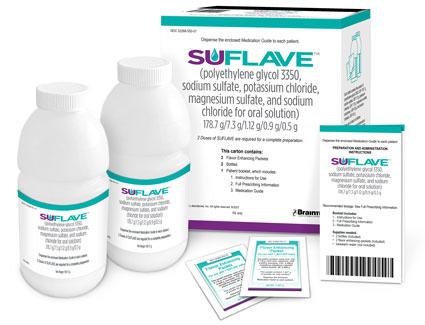Polyethylene glycol 3350 with electrolytes Disease Interactions
There are 7 disease interactions with polyethylene glycol 3350 with electrolytes.
- Inflammatory bowel disease
- Intestinal obstruction disorders
- GI obstruction/perforation
- Arrhythmias
- Impaired gag reflex
- Renal disease
- Seizures
Laxatives (applies to polyethylene glycol 3350 with electrolytes) inflammatory bowel disease
Major Potential Hazard, Moderate plausibility.
The use of laxatives is contraindicated in patients with inflammatory bowel disease. Patients with inflammatory bowel disease may experience colonic perforation with use of stimulant laxatives.
Laxatives (applies to polyethylene glycol 3350 with electrolytes) intestinal obstruction disorders
Major Potential Hazard, Moderate plausibility. Applicable conditions: Gastrointestinal Obstruction
The use of laxatives is contraindicated in patients with intestinal obstruction disorders. Patients with intestinal obstruction disorders may need their underlying condition treated to correct the constipation. Some laxatives require reduction in the colon to their active form to be effective which may be a problem in patients with intestinal obstruction.
PEG solutions (applies to polyethylene glycol 3350 with electrolytes) GI obstruction/perforation
Major Potential Hazard, High plausibility. Applicable conditions: Gastrointestinal Obstruction, Gastrointestinal Perforation, Ulcerative Colitis
The use of polyethylene glycol (PEG) solutions is contraindicated in patients with gastrointestinal obstruction, perforation, or toxic megacolon. If gastrointestinal obstruction or perforation is suspected, appropriate studies should be performed prior to administration of these agents. Use with caution in patients with severe active ulcerative colitis. Increased activity of the gut caused by these agents could worsen these conditions.
PEG electrolyte solutions (applies to polyethylene glycol 3350 with electrolytes) arrhythmias
Moderate Potential Hazard, Moderate plausibility. Applicable conditions: Heart Disease
The use of ionic osmotic laxative products for bowel preparation has been associated with rare reports of serious arrhythmias. Use caution when prescribing PEG electrolyte solutions in patients at increased risk of arrhythmias (e.g., patients with a history of prolonged QT, uncontrolled arrhythmias, recent myocardial infarction, unstable angina, congestive heart failure, or cardiomyopathy). Clinical monitoring of cardiovascular status is recommended prior to, during, and after therapy.
PEG electrolyte solutions (applies to polyethylene glycol 3350 with electrolytes) impaired gag reflex
Moderate Potential Hazard, Moderate plausibility. Applicable conditions: Esophageal Obstruction
Patients with impaired gag reflex, unconscious or semi-conscious patients, and patients prone to regurgitation or aspiration should be administered polyethylene glycol (PEG) electrolyte solutions cautiously. Patients experiencing severe bloating, distention or abdominal pain may need to receive PEG electrolyte solutions at a slower rate.
PEG electrolyte solutions (applies to polyethylene glycol 3350 with electrolytes) renal disease
Moderate Potential Hazard, Moderate plausibility. Applicable conditions: Renal Dysfunction, Dehydration
Use caution when prescribing PEG electrolyte solutions to patients with impaired renal function or patients taking concomitant medications that may affect renal function. Ensure adequate hydration and consider performing baseline and post-colonoscopy laboratory tests (electrolytes, creatinine, and BUN) in these patients.
PEG electrolyte solutions (applies to polyethylene glycol 3350 with electrolytes) seizures
Moderate Potential Hazard, Moderate plausibility. Applicable conditions: Hyponatremia
PEG electrolyte solutions have been associated with seizure activity, and/or loss of consciousness. The seizure cases were associated with electrolyte abnormalities and low serum osmolality. Therapy with these agents should be administered cautiously in patients with a history of or predisposition to seizures or in patients with known or suspected hyponatremia.
Switch to professional interaction data
Polyethylene glycol 3350 with electrolytes drug interactions
There are 397 drug interactions with polyethylene glycol 3350 with electrolytes.
Polyethylene glycol 3350 with electrolytes alcohol/food interactions
There is 1 alcohol/food interaction with polyethylene glycol 3350 with electrolytes.
More about polyethylene glycol 3350 with electrolytes
- polyethylene glycol 3350 with electrolytes consumer information
- Check interactions
- Compare alternatives
- Reviews (1,133)
- Side effects
- Dosage information
- During pregnancy
- Drug class: laxatives
Related treatment guides
Drug Interaction Classification
| Highly clinically significant. Avoid combinations; the risk of the interaction outweighs the benefit. | |
| Moderately clinically significant. Usually avoid combinations; use it only under special circumstances. | |
| Minimally clinically significant. Minimize risk; assess risk and consider an alternative drug, take steps to circumvent the interaction risk and/or institute a monitoring plan. | |
| No interaction information available. |
See also:
Further information
Always consult your healthcare provider to ensure the information displayed on this page applies to your personal circumstances.


